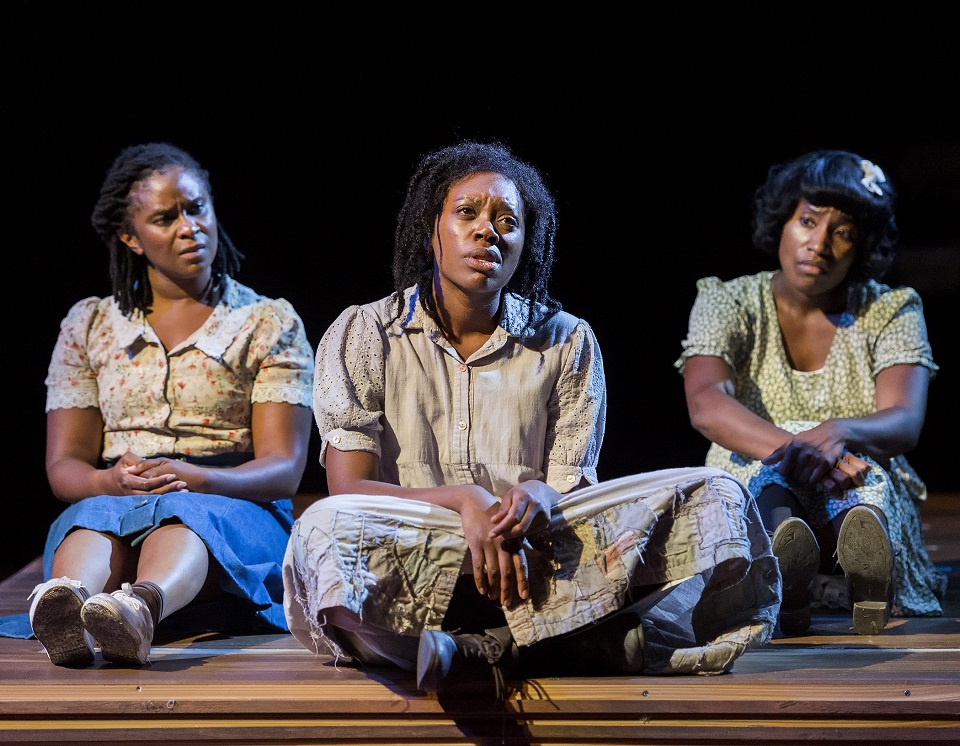
PASADENA, Calif –– A mirror plays an essential role in The Bluest Eye, a dramatization by Lydia R. Diamond from the novel by 1987 Pulitzer and 1993 Nobel Prize-winning author Toni Morrison (1931-2019) that’s now on stage at A Noise Within, directed by Andi Chapman as the opener to its 2023-24 “Balancing Act” season. Morrison gave her approval to Diamond’s script. Chapman listened to Morrison’s own audiobook reading of the novel more than a dozen times to capture the author’s inflections and nuances. Among the many productions Chapman has helmed are Native Son and The Abuelas.
The 1970 novel, Morrison’s first, concerns three young Black girls in the early 1940s in Lorain, Ohio (Morrison’s hometown) as they struggle to make sense of love, sisterhood, physical and psychological abuse, and racial hate. Black society mirrors white society, Black physical features mirror Caucasian characteristics, including those found in the classic Dick and Jane early schoolbooks, on the wrappers to Mary Jane candies, and in the popular Shirley Temple movies. Even white and Black readers—and Black and white playgoers—are likely to have mirrored reactions to the work.
Faced with constant ridicule and abuse for her looks, 11-year-old Pecola Breedlove blames her dark skin. If only she had blue eyes, surely, she fantasizes, she would merit the love she’s been denied in life. The two sisters in the family that takes her in as a temporary “foster” child, Claudia and Frieda, empathize with Pecola’s hard circumstances while expressing bewilderment and frustration with her blue-eyed obsession. Frieda—like the “weird Barbie” in the current box-office hit film—actually takes to smashing a white doll that to her represents all that is wrong with the racist assumptions Black kids grow up with.

“The origin of the novel lay in a conversation I had with a childhood friend in elementary school,” wrote Morrison in her author’s note. “She said she wanted blue eyes. I looked around to picture her with them, and was violently repelled by what I imagined she would look like if she had her wish. Implicit in her desire was racial self-loathing. Twenty years later, I was still wondering about how one learns that. Who told her? Who made her feel that it was better to be a freak than what she was? Who had looked at her and found her so wanting, so small a weight on the beauty scale? The novel pecks away at the gaze that condemned her.”
Perhaps the Andy Razaf song lyric to “Black and Blue” by “Fats” Waller says it most succinctly: “What did I do to be so black and blue?” With so few in the public sphere offering positive images of African-Americans, how easy it could be to feel one was somehow personally responsible for being treated so bad.
The very name “Pecola” may lend a clue to the meaning of her character. An internet search turns up a wide range of possible derivations, including one from Zulu. But I could not dismiss from mind the similarity with the Latin word “peccata,” as in “peccata mundi,” the sins of the world. It’s almost as though this unfortunate child had become the repository of the whole world’s ugliness—as her last name, Breedlove, promises an almost Christ-like redemption. (By the same token, I also can’t help wondering why Shakespeare chose the name “Desdemona” for Othello’s wife—“from the demon.” Did he mean to imply that in Othello’s mind, all the racism and contempt he experienced in life could be projected onto her?)
Inevitably, Black audiences will read this story in a profoundly personal way, while white people exposed to it will understand it more as an artistic statement with its elevated, poetic, often ironically detached language.
I’m currently reading a collection of writings by Michael Denneny, On Christopher Street: Life, Sex, and Death After Stonewall, for future review, and coincidentally encountered this brief passage from a 1987 literary interview with writer Allen Barnett touching on oppressed communities in America and the literature they produce. “I remember once seeing a young Black girl carrying The Bluest Eye, a book I liked immensely,” Barnett reflects, “although it seemed more important that she read the book than I” (p. 197).
To which Denneny answers, “It would matter to her and her life and her spirit in a way that it would never matter to you. For you, it would be an aesthetic product as opposed to a product of the living culture.”
That is exactly how on my (white) side of the mirror I experienced the play, while all around me the substantial number of Black theatergoers on opening night (Sept. 2) nodded and murmured their assent at each one of Morrison’s sharp, pungent observations about race in America. As with books, so the theater and all the arts: Every self-identified community needs its literary and aesthetic warriors to guide their generation in defining and refining the contours of the mirrors in their time. Outsiders are invited to eavesdrop, as it were, as readers and theatergoers, to see if the issues brought up correspond in some ways to their own experience. Many people—most, perhaps—have felt ostracized or bullied for one thing or another, such as weight or religion, sexuality, accent, or neurodiversity.
The Bluest Eye painfully exposes the poisonous effects of systemic racism and the heartbreak of shame, all the while retaining the distinctively rich and lyrical language of Morrison’s novel that has kept it evergreen on young readers’ reading lists.
“Morrison wants us to understand that racism hurts, and what transpires when it becomes internalized by the most vulnerable among us— a child,” says Chapman. “The ‘White gaze’ that we hoped to leave behind in the South, along with slavery, Reconstruction and Jim Crow, has followed these characters north, to Lorain, Ohio.” The blue-eyed imagery Pecola embraces from the culture surrounding her is “an ideal she can never meet” given the essential inferiority she feels. Escaping segregation in Dixie, Black people in Lorain found its Northern mirror at Lakeshore Park, from which they were excluded.
The script often brings in metaphors for despised groups—an old hound, occupying his perch on a front porch, that is decrepit nevertheless lovable, and dandelions that are beautiful but condemned as a weed.
With its frank depiction of racism, domestic violence and alcohol abuse, The Bluest Eye has appeared several times on the American Library Association’s annual list of top 10 most challenged books. According to PEN America, the book has been banned by 32 school districts across the country during the last two school years alone (2021-22 and 2022-23). Such is the power of truth-telling in an era devoted to the death of “woke.” “Sharing a play as important as this is why we exist,” says A Noise Within co-artistic director Geoff Elliott.

One more evocation of “mirroring,” in both the novel and the play, is a mirror of time. The telling of the story shifts between the young girls themselves and their community (there are eight actors on stage—six women and two men), and the omniscient narration of recall by the wise, thoughtful adults, especially Claudia, these girls have become in later years. The effect of action in both real time and reflected time, often simultaneous, is a constant feature.
A Noise Within has assembled a peerless cast, with most of them playing multiple roles. Akilah A. Walker heads the troupe as Pecola Breedlove, alongside Kacie Rogers and Mildred Marie Langford as sisters Claudia and Frieda. Julanne Chidi Hill plays a most sympathetic Mrs. Breedlove, and Kamal Bolden is Cholly Breedlove, her profoundly troubled husband, whose problems have an explicit backstory that we see. Crystal Jackson and Alex Morris are Claudia’s and Frieda’s Mama and Daddy—Morris, a familiar presence in this theater’s August Wilson plays, also steps into several other brief but glorious appearances as Soaphead Church and a fortuneteller. Alexandra Metz plays the pretentious “high yellow” classmate Maureen. Most of the actors are making their company debuts here. Director Andi Chapman opted for a kind of choral approach to the dialogue, with many solos, of course, but also times of overlapping and group speech with lots of musical interludes.
While quite a number of scenes feature the entire cast on the plain thrust stage that is the hallmark of this theater almost in the round, when they are not engaged in the action they can be seen toward the back of the stage: Each has their own high-backed chair, as though they were African royalty, awaiting their next cue. The visibility of the entire cast on stage at all times, and the presence of industrial shelving in the middle of the backstage area that stores the play’s props, reminded me of the exposed Bauhaus manner in which plays of that bygone era such as Our Town and The Cradle Will Rock are frequently mounted. The simplicity of the décor is intentional: “It’s just text, music and actors,” says Chapman. “It’s like a symphony quilting of the story.”

The creative team includes composer and musical director Maritri Garrett and choreographer Indira Tyler; scenic designer Fred Kinney; lighting designer Andrew Schmedake; sound designer Jeff Gardner; costume designer Wendell C. Carmichael; wig and makeup designer Shelia Dorn; properties designer Stephen Taylor; and dramaturg Dr. Miranda Johnson–Haddad. The production stage manager is Zaira Paredes-Villegas. The production featured split-second sound cues such as knocking on doors, or kitchen noises that corresponded precisely to the actors’ gestures, at times almost comically.
One of the most significant American novels of the 20th century, by one of our most influential writers, receives a pitch-perfect realization here, and deserves to be widely supported and enjoyed. Few theatergoers will leave untouched by this courageous little miracle.
The Bluest Eye runs through Sept. 24 on Thurs. at 7:30 p.m., Fri. at 8 p.m., Sat. at 2 and 8 p.m., and Sun. at 2 p.m. (dark Thurs., Sept. 14, and no evening performance on Sat., Sept. 23). Discount tickets are available for groups of 10 or more. Post-performance conversations will take place every Fri. and on Sun., Sept. 10. In addition, there will be three student matinees at 10:30 a.m. on Thurs., Sept. 14, Tues., Sept. 19, and Weds., Sept. 20. Interested educators should email education@anoisewithin.org. The play runs 100 minutes without intermission.
A Noise Within is located at 3352 E. Foothill Blvd., Pasadena 91107. The Bluest Eye is recommended for mature audiences ages 14 and up. For more information and to purchase tickets, call (626) 356–3100 or go to www.anoisewithin.org.
We hope you appreciated this article. At People’s World, we believe news and information should be free and accessible to all, but we need your help. Our journalism is free of corporate influence and paywalls because we are totally reader-supported. Only you, our readers and supporters, make this possible. If you enjoy reading People’s World and the stories we bring you, please support our work by donating or becoming a monthly sustainer today. Thank you!












Comments